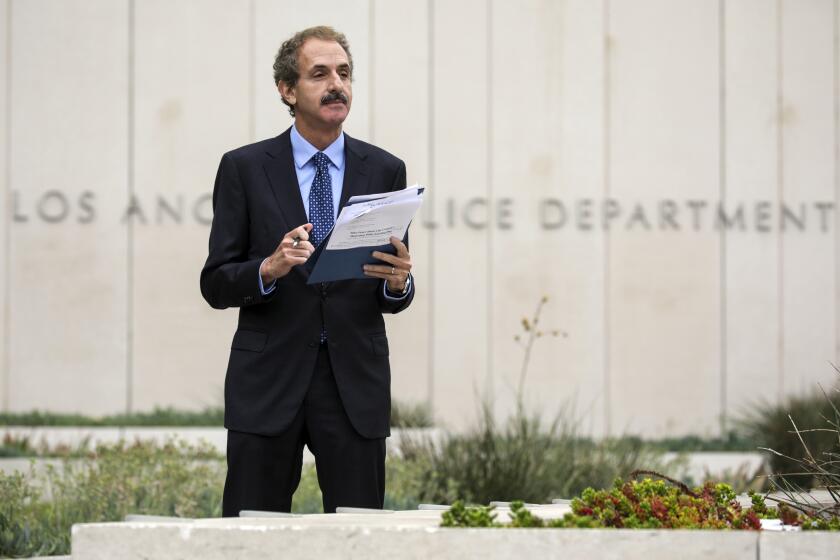Orange County D.A. Seizes Records in Investment Probe : Crisis: Offices of treasurer and auditor are targeted. The investigation appears to focus on what investors were told about the risks involved in the county fund.
Armed with search warrants, investigators from the Orange County district attorney’s office scoured the offices of the county’s treasurer and auditor Monday, launching a criminal probe into the risky investment practices that plunged the county into an unprecedented bankruptcy crisis.
Sealing off the hallway leading to former Treasurer Robert L. Citron’s office with yellow crime-scene tape, about 30 investigators--including some from the Securities and Exchange Commission and the State Department of Corporations--combed through files, removing boxes of documents and computers and loading them into two vehicles.
In a nearby government building, authorities collected audits of the investment portfolio conducted by Auditor-Controller Steve E. Lewis. Investigators, he said, were particularly interested in a 1993 audit that criticized Citron’s investment strategies and said state laws were being violated.
At the treasurer’s office, investigators appeared to be focusing on documents that could shed light on Citron’s investments and precisely what cities, schools and special districts with savings in the fund were told about the risks of those investments.
Investigators said they would be collecting documents from the treasurer’s office throughout Monday night. While the probe continued, these developments took place Monday:
* County officials said Monday they were preparing to cut about 25% out of this year’s budget because of the loss of interest revenue. The cuts, however, will not be shared equally among county departments. Public safety and welfare services are a higher priority, officials said.
* At the urging of the county’s management council--composed of Dist. Atty. Michael R. Capizzi, Supervisor Gaddi H. Vasquez, Sheriff Brad Gates and Health Services Agency Director Thomas Uram--the Superior Court system offered to trim $1 million from its budget, largely by allowing 35 to 45 jobs to remain unfilled, according to Assistant Presiding Judge Ted Millard. Officials in other county departments declined to comment on possible cuts.
* Salomon Bros., the brokerage handling the liquidation of the fund’s portfolio, said the fund will receive $598 million in cash from the $1.39 billion raised in last week’s initial sale. The rest of the proceeds--$792 million--were used to pay down some of the loans still outstanding to the fund from major brokerage houses. Meanwhile, Salomon on Monday sold an additional $175 million in securities.
* Investors in the county fund learned that property taxes collected earlier this month will be released Friday to all public agencies. “We’re seeing step by step that we’re going to see a resolution to this,” said Blake Anderson, general manager of the Orange County Sanitation District, which will receive about $20 million in property taxes.
* The Securities and Exchange Commission announced that it had filed a motion that allows it to be a formal part of the bankruptcy proceedings and monitor the distribution of funds.
* In Sacramento, a special Senate committee held its first meeting to look into the Orange County investment debacle and several lawmakers raised doubts that the state can offer much assistance. “I’ve got a feeling a lot of these local governments are going to come up here with their hands out and ask us to bail them out,” said Sen. Dan Boatwright (D-Concord). “We don’t have the money to bail them out. . . . We’re in a hole.”
* The city of Anaheim turned down an $8.5-million disbursement offered by the county because city officials did not want to be restricted to spending the money on emergency payroll and purchasing commitments, officials said.
* A federal bankruptcy judge approved $126.6 million in disbursements to some investors who sought money from the pool. Among the disbursements were $115 million to the Orange County Department of Education, community colleges and other schools, and $4.6 million to the Orange County Water District.
* At a Huntington Beach City Council meeting, outgoing Councilman Jim Silva, who will be sworn in next month as one of two new county supervisors, said his first action will be to propose that the county treasurer be appointed and not elected.
Silva said the treasurer should be selected by the county chief administrative officer and approved by the Board of Supervisors.
No Limits on Inquiry
At an impromptu news conference Monday afternoon, Capizzi said the two search warrants were the only ones executed in the case so far, but refused to rule out future warrants. Nor would he discuss the scope or aim of his case. “We’re not giving road maps (on the investigation), past or future,” he said, adding that investigators will not limit their inquiry.
The district attorney’s office joins a host of other agencies--including the U.S. attorney’s office and the Securities and Exchange Commission--that are examining Citron’s investments in the wake of the county’s bankruptcy filing two weeks ago. Much of the investigation focuses on whether Citron misled investors and whether brokers sought to influence county officials to gain underwriting business by providing them with kickbacks.
Terry W. Bird, attorney for acting Treasurer Matthew R. Raabe, said Monday’s actions by Capizzi’s office were unnecessary.
“This is not a criminal case. Why he’s executing search warrants on the treasurer’s office, you’ll have to ask him,” Bird said. “Somebody decided they need to seal it off with a yellow tape. That was not necessary. These people would have given them anything they wanted.”
Previously, two district attorney’s investigators had been rebuffed in attempts to speak with Raabe.
Lewis, the county auditor-controller, said he had “nothing to fear” from a criminal investigation. “My records are open,” he said.
Investigators arrived at the county offices about 10 a.m. Salomon Bros. officials also were present, said an investigator who declined to be named.
At least 13 boxes, numbered and labeled “Treas.” were loaded into an orange van. Computers and other boxes were loaded into a second vehicle.
Also at the scene was Deputy Dist. Atty. William Overtoom, who specializes in prosecuting white-collar crime, including fraud and embezzlement. Overtoom declined to discuss his involvement in the execution of the search warrants.
County employees gathered a short distance from the commotion. “It’s like a morgue in there. Terrible, terrible, terrible,” said Rena Bugbee, a deputy tax collector.
‘Stop-Gap Measure’
As public agencies continued to cope with the fallout from the financial crisis, Ron Rus, an attorney who represents six local districts with money tied up in the fund, described the emergency disbursement of the $126.6 million as “a very interim stop-gap measure.
“We don’t view the amount disbursed on Monday as having any significant impact on the interests of other participants in the pool,” Rus added.
Meanwhile, officials from some agencies who mistakenly believed that their funds were being invested in a separate, safer pool were preparing to argue that they should be among the first in line to get their money back.
All told, the Orange County Transportation Agency, the Orange County Sanitation District and 11 other public entities had sunk an estimated $1.3 billion in less risky investments--or so they believed.
In actuality, it appears as if Citron pooled all money in one fund composed of numerous high-risk investments.
Particularly stung by the revelation that apparently no safer pool of funds existed was the sanitation district, which invested about $50 million in what officials believed was safe on assurances from Citron.
An April 12, 1993, letter from Citron to district general manager J. Wayne Sylvester all but guaranteed that the money would be safe, indicating that it was not going into a “commingled fund,” but into a separate one with lower risks.
“We are doing the district an extreme favor,” Citron said in the letter. “We, therefore, do not want this type of investment transaction disseminated to others.”
The confusion over the alleged existence of separate funds was worsened by monthly statements from Citron charting performances for both a “bond pool” and an “investment pool,” the latter believed to have been the higher-risk pool of commingled funds.
Stan Oftelie, chief executive officer of the Orange County Transportation Authority, said, “We believed that the bond pool had safer, lower-yield investments and the commingled pool had riskier investments.”
“There are supposed to be two pools,” said Ken Weel, chief financial officer for the Santa Margarita Water District, one of the 13 agencies. “We got separate statements on each pool.”
The distinction between the two funds is significant because, under federal law, the tax-exempt monies that were pumped into the pool by the 13 agencies cannot be used for arbitrage, or borrowing to make a profit. In exchange for assuming lower risks, the agencies would receive a lower rate of return.
Officials first received indications that their so-called “safe” deposits would be tied up in the financial mess at an investors meeting Thursday.
Officials also questioned the propriety of Citron’s pooling all the money in a single fund, thus subjecting them to the same amount of risk, but paying some agencies lower yields.
Citron’s attorney, David Wiechert, did not return telephone calls Monday.
Patrick C. Shea, an attorney with Pillsbury Madison & Sutro, which has been retained by a committee of investors seeking return of their money, said it is unclear how Citron’s accounting methods will affect the disbursement of funds.
Shea said he does not expect the possible claims by some investors that their funds are more secure to disrupt the negotiation process or fracture the investors committee. Unlike committees in other types of bankruptcy filings, “the members of this committee are county agencies and they all live here and they’re all neighbors forever. It’s like they’re all married,” he said.
Shea added that he expects all the investors will receive pro-rated shares of money that came into county coffers after the bankruptcy declaration was filed, such as recently received property tax revenue. School districts were given special assurances from the Board of Supervisors over the weekend that they would receive their fair shares of the property tax payments, but Shea said other investors should receive the same treatment.
Anaheim Decision
While municipalities throughout the county clamored for cash, Bret Colson, spokesman for the city of Anaheim, said officials there turned down an $8.5-million disbursement offered by the county because the money could be spent only on emergency payroll and purchasing commitments.
“The city is not in emergency mode with respect to payroll and purchasing,” Colson said. “If (the county) hadn’t put any restrictions on it, we would have accepted the money to meet general operating expenses.”
Colson said city officials will re-evaluate their position on the disbursement after Christmas. The city has $169 million invested in the fund, 20% of its total investment portfolio of $874 million.
Santa Ana, which defaulted on a $5.3-million debt service last week, will learn later this week if the county will release the $9.6 million the city needs to continue a massive jail construction project.
“If we get the money this week, we’ll be fine,” City Manager David N. Ream said Monday.
The city will be forced to halt the project if it cannot come up with the debt service payment and the $4.5 million in contractor’s fees that are due this month.
County’s Cash Intake
As creditors continued to pick through the financial wreckage this week, county adviser Salomon Bros. revealed that the county’s investment portfolio will take in only $598 million in cash from the $1.39 billion it raised in last week’s initial sale of securities. The balance--$792 million--went to pay down some of the loans still outstanding to the fund from major brokerages.
Salomon also said Monday that it had failed to count $390 million in loans in its initial valuation of the fund a week ago, when it estimated the total loan amount at $2.56 billion.
But Salomon said that because the $390 million loan it missed was fully collateralized, the gross market value of the securities in the fund--listed last week as $7.96 billion--also was undercounted by $390 million.
The end result, the brokerage said, is a wash. The original $5.03 billion that Salomon estimated could be recovered for the fund by liquidating its securities still is accurate, the brokerage said. If that much is raised, the fund’s investors will have lost 27% of their investment.
Salomon raised the additional $175 million for the fund Monday by selling a handful of securities. Negotiations are continuing between Salomon and the U.S. government agencies that issued the bulk of the more complicated “derivative” bonds owned by the fund.
Salomon hopes to restructure those securities with the agencies rather than sell them on the open market, but officials on both sides say they are not sure they can strike a deal before January.
More on Bonds
* Reprints of two articles by Tom Petruno about bond transactions are available through Times on Demand. Call 808-8463, press *8630 and select Option 1. Order Item No. 2811. $3.95. News and analysis of the Orange County bankruptcy, including profiles of the key players, are also available on TimesLink.
More to Read
Start your day right
Sign up for Essential California for news, features and recommendations from the L.A. Times and beyond in your inbox six days a week.
You may occasionally receive promotional content from the Los Angeles Times.






